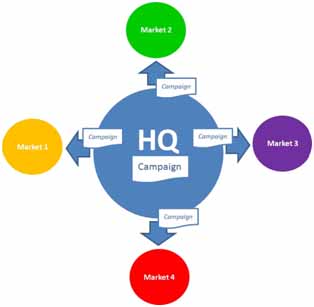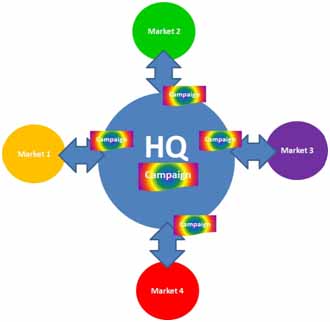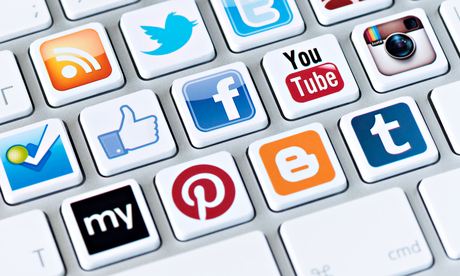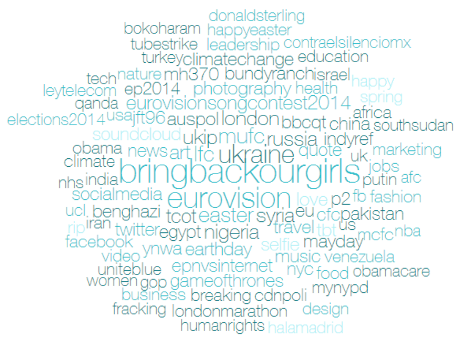http://www.smartinsights.com/online-brand-strategy/international-marketing/how-social-and-digital-marketing-has-impacted-global-branding/
How social media and digital marketing has impacted global branding
Examples of companies successfully using social media to enhance their brand and increase sales.
A few months ago, Coca-Cola launched what they refer to as the ‘Cocal-Cola TV project’ campaign, essentially bringing live entertainment to its target audience via multiple social media channels and devices in a year-long project primarily aimed at audiences in Latin America. Paul McCartney’s free concert in Mexico was streamed live on Coca-Cola TV, with viewers encouraged to drive conversations on social media channels.
More recently, Topshop partnered with Facebook to allow viewers of its live-streamed fashion show to share pictures of their favourite outfits with their friends as the show unfolded. The show was also the first ever fashion show to be streamed live on Twitter, with viewers encouraged to summarise the show in the traditional 140 characters. According to the brand, it was watched by over 2 million viewers from over 100 countries. The campaign resulted in an extraordinary level of traffic to Topshop.com, and in several of the collection’s items being sold out within an hour.
So how is global marketing evolving and how to make the most of this opportunity?… 3 stages to a campaign development process
- Stage 1: domestic market or HQ focus
Traditionally, global marketing campaigns were developed in a brand’s headquarters, and tailored to cater for the needs of the largest market. They were then tweaked to smooth out prominent local flavours, and to create a more ‘global friendly’ tone of voice. However, the content and concept remained predominantly relevant for the primary market they were intended for.
They were then tweaked to smooth out prominent local flavours, and to create a more ‘global friendly’ tone of voice. However, the content and concept remained predominantly relevant for the primary market they were intended for.
 They were then tweaked to smooth out prominent local flavours, and to create a more ‘global friendly’ tone of voice. However, the content and concept remained predominantly relevant for the primary market they were intended for.
They were then tweaked to smooth out prominent local flavours, and to create a more ‘global friendly’ tone of voice. However, the content and concept remained predominantly relevant for the primary market they were intended for.
Benefits and Risks:
The benefit?A cost effective way of ‘globalising’ a market-specific campaign. The risk?A potentially bland and soulless campaign, or worse still one that crosses the line of accepted cultural norms and might even be perceived as offensive in certain markets.Diesel’s ‘be stupid’ ad campaign for example had to be pulled out of the UK after being deemed inappropriate.
- Stage 2: domestic and international focus
Over time, the process evolved and became more fluid. Brands learned to operate with a more international mindset and produce campaigns relevant across a range of markets. They managed to reach the fine balance between keeping global cohesion and branding, and integrating cultural flavours.

In-market marketers actively participated in the ideation and development of the campaign to make sure that it hit the spot in their market.Equally, global marketers became savvier in their knowledge of the various cultures (and underlying languages, regulations, accepted behaviours, etc.) their brands operated in.
- Stage 3: global focus
More recently, the emergence of digital and social media marketing has led brands to embrace global marketing at a much deeper level. The lines between separate markets have become blurred. Digital campaigns ran in one region inevitably ‘leak’ to others via social media channels, as are the public’s comments, reactions and opinions, whether positive or negative.
This approach has worked particularly well for certain brands. Coca-Cola for example arguably established the early concept of global marketing and has managed to keep its slogans universal through the years. From ‘Have a Coke and smile’ in 1979 to ‘Can’t Beat The Feeling’ in 1989 and ‘Always Coca-Cola’ in 1993, its taglines appealed to its audience’s feelings – universally so.
How Nike succeeded?
Nike has also placed the bar pretty high when it comes to embracing digital as a platform to drive global campaigns. The days of promoting the start of NCAA March Madness (a US-based basketball tournament) on its homepage in every country are thankfully long gone. A shift certainly happened when Nike launched the Nike iD online store, allowing customers to customise their own shoes.It was a hit, with sales reaching over $100 million in a few years. Nike has not looked back since.
They identified that developing products that allow them connect with their target customers on a personal level across a multitude of cultures and markets was a key success driver. They also smartly combined this with an increased emphasis on social media as an advertising medium. In fact, Nike’s World Cup Campaign in 2010 was launched via its Football’s Facebook page.
On benefits of social media
This week, as late spring sun breaks through the clouds, we are in a highly positive mood, exploring beneficial effects of social media on mood and positivity of brand interactions on Twitter.

Photograph: Anatolii Babii/Alamy
Twitter is the most positive social network
At least when it comes to interacting with brands. We know through Keller Fay's TalkTrack that 62% of all brand mentions (online and offline) are positive and only 10% are negative.
Now a study by social media consultancy Converseon shows a similar dynamic on social media. Converseon looked at direct user interactions with 20 leading global brands and found that 55% of those that took place on Twitter were positive in nature, with an additional 25% neutral. On Facebook, 49% of interactions were positive, with Google+ falling in the middle, reports eMarketer.
On all three social networks studied, interactions were more likely to be neutral than negative—and overwhelmingly likely not to be negative. At most, one-fifth of all such interactions went badly.
Social media makes us happy
Speaking about positivity: the Guardian's latest "Mood of the Nation" research conducted among 2,000 nationally representative sample of UK adults, found that using social media was the number one activity that made people happy, above money, family and friends.
"What makes me happy" – top choices:
1. Using social media
2. Playing computer games
2. More money
3. Spending time with family
3. Spending time with friends
3. Shopping
4. Sports events
4. Brands I like
4. Relaxing
2. Playing computer games
2. More money
3. Spending time with family
3. Spending time with friends
3. Shopping
4. Sports events
4. Brands I like
4. Relaxing
Douze points for Eurovision
Last week's Eurovision Song Contest 2014 dominated Twitter, generating 5.4m tweets across Europe (vs. last year's 3.8m), according to stats from the social network. Austria's entry Conchita Wurst triggered a record-breaking enthusiasm on Twitter, resulting in an average of 47,136 tweets per minute.
We've looked at the word cloud of all UK twitter activity in the 30 days to 12 May 2014 and Eurovision came as a clear winner (PeerIndex PiQ data).

Amongst @guardian followers, Eurovision was also popular, only behind the #BringBackOurGirls campaign.

Be more human to be heard
PeerIndex gives advice to brands on surviving Twitter's new "mute" function, whereby users are able to remove updates from irritating @usernames from their timeline. In order not to get muted, PeerIndex suggests that brands need to:
- Engage with users, rather than promoting competitions
- Help followers, rather than buying followers
- Create entertaining content, rather than "in your face" advertising
- Behave like humans, rather than brands
- Help followers, rather than buying followers
- Create entertaining content, rather than "in your face" advertising
- Behave like humans, rather than brands
http://www.adweek.com/news/television/digital-media-now-bigger-national-tv-advertising-will-surpass-total-tv-2018-158360
Digital Media Is Now Bigger Than National TV Advertising, Will Surpass Total TV by 2018
The World Cup is killing it
Magna Global issued a report on Monday predicting a major upswing of 8.3 percent for U.S. television advertising revenue in 2014, after a dismal 2013 in which revenues were down 0.6 percent. But there's been one significant change: national TV advertising is now smaller than digital media advertising.
The World Cup, local political advertising, and the Olympics are among the factors contributing to the uptick, said Vincent Letang, Magna's evp, director of global forecasting. Letang also predicted serious movement in the global mobile markets, among other trends—including that digital will surpass total TV by 2018.
"National TV benefited from the Olympics in the first quarter. Local TV will gain from political and health-related campaigns throughout the year. Hispanic TV will be boosted by the soccer World Cup," noted the report. Letang added that "there is really a two-year cycle to television."
"Elections make a huge difference for U.S. television," he said. "Television is resilient to digital media and [is] still stealing market share from other traditional categories. People are moving money out of print and putting it in digital but still some in television."
But the additions to digital are very significant. Indeed, said Letang, digital media is projected to increase by 15.9 percent globally this year—but only because a comparatively weak increase in nonmobile viewing (where the majority of the money currently is) of 8 percent drags down an incredible 61 percent jump in global mobile ads.
"[Much of this is due to] the amazing success Facebook is having with mobile apps and mobile usage," said Letang. "In some markets like India for example, mobile is the bulk of all users—the desktop penetration is probably lower in mobile. But you can run Facebook on relatively simple apps on cheap feature phones. So that explains the rise of social in countries without tablet or smartphone penetration." Lower-tech apps, in fact, result in much greater adoption globally.
Regarding the World Cup, Letang said the contest is "bigger than it's ever been because it's Brazil, so it's raising the interest of even casual viewers who wouldn't necessarily be soccer fans." Though Letang admits that the contest is "optimized for Western Europe," he thinks it's going to be bigger every cycle, and global brands are taking notice. "It's probably helping digital media monetization," Letang said. "It's not only about TV these days; it's about social and online video replays. It's about multiple viewings."
A few bullet points from the U.S. section of the report:
- Digital media advertising revenue grew by +17% in 2013 to $43 billion.
- Within digital, mobile-based ad sales grew by +110% (vs. +8% for desktop-based advertising) to reach 17% of total digital media revenue.
- Social media advertising grew by +53% to $3.6 billion.
- With a 27% market share in 2013, digital media is now bigger than national TV, but still significantly smaller than television as a whole (TV commands 40% market share).
- Digital media advertising sales are expected to to increase by +14.4% in 2014 and ultimately surpass total television by 2018. Print advertising will continue to decrease by approximately -7%, while radio revenues will be flat and outdoor media will grow by +3.7%.
No comments:
Post a Comment